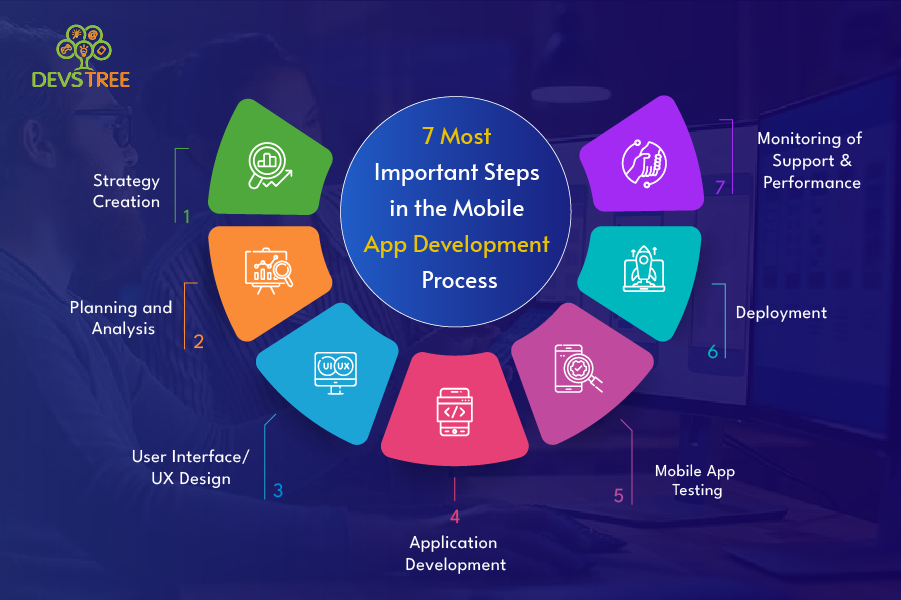
Mobile fever has completely engulfed today’s globe. It is becoming increasingly difficult to picture a life without smartphone apps. They are taking over the world, and this is no longer a distant future, but rather a genuine reality. With such hopeful projections, it’s simple to see why so many businesses are interested in the mobile app development industry. In any case, if your company is interested in establishing a mobile solution, understanding the mobile app development process is essential. Today, we’ll give mobile app-building guidance based on our expertise. Let’s get started.
The 7 Most Important Steps in the Mobile App Development Process
Individual differences exist in the process of Mobile App Development Platforms. However, the following seven steps are the most likely to be required:
Strategy Creation:
Each app begins with an idea. The customer outlines what duties the future service should fulfil and why a mobile application is being developed. This aids in understanding how users will interact with the programme to make it as convenient, understandable, and valuable as feasible.
The next step is to create a thorough Terms of Reference (TOR). It often includes a full explanation of user personas, user stories (User stories), a Customer Journey Map, mobile app features, business processes, and the primary scenarios to be implemented. It is feasible to precisely estimate the time and cost of app development after preparing the ToR.
The result is a list of application functionalities, interface requirements, performance and other non-functional needs, a description of how all of these requirements will be executed, and project cost estimates.
Planning and Analysis:
The second step in the application-building process is analysis and planning. You already have an idea, have done some research, and have a broad notion of where you’re going. Now is the moment to get hands-on and figure out all of the intricacies before diving into the design and development stages. You must be explicit about the actions you want your mobile app to accomplish.
You’ll need skilled iOS developers if you’re creating an iOS app. If you want to create a cross-platform programme, you’ll need someone familiar with technologies for multi-platform development.
Read more Article- What Will It Cost to Develop a Mobile App in 2025?
User Interface/UX Design:
Interaction between application components is a component of UX design. At this point, you can examine how the app operates in various user scenarios. This is the registration order, the personal account view order, and the checkout and payment order.
UI design is concerned with the appearance of the application. The designer chooses the colour palette and works on the interface. If the organisation has a style and corporate colors, the design is created by them.
Application Development
The development team creates code to achieve the desired application behaviour and connects the application logic to the server component if one is available. The service code is developed in two stages: frontend and backend. The front end is responsible for the design and development of the application’s client interface and business logic. The backend is the establishment of the service’s server component, which is in charge of data transfer.
The server should ideally be designed in such a way that information exchange between it and the front is smooth. We now have a mobile application that is ready for testing at the end of this round.
Mobile App Testing:
When you’re finished with app creation, it’s time to start testing. After all, you want to ensure that the developed solution is stable, safe, and free of flaws. Before deployment, your app should go through five different types of testing to ensure the greatest quality delivery.
Functionality
This is the stage at which you test your application’s functionality and confirm that everything works properly.
Performance
You should pay attention to your app’s responsiveness and how it handles an increase in concurrent users during performance testing.
Security
Data protection is critical when developing enterprise solutions such as mobile insurance apps and healthcare apps that operate in highly regulated industries.
Deployment:
When you’re finally ready to publish your app, you’ll have to go through several distribution strategies depending on the platform for which you developed it.
The strategy for deploying mobile applications is straightforward. You’ll need to either submit your programme to Apple’s App Store, or Google Play Store or go with the private distribution.
Monitoring of Support and Performance
After the application is out, it must be regularly maintained. Ensure that the server can manage the demand and that any faults that develop are fixed. You can improve the application by examining user comments and making refinements, releasing updates, and expanding functionality depending on it. Keep note of crashes, bugs, customer requests, and general app performance as well. You’ll be able to improve your solution over time if you do this.
Bottom line:
Devstree IT Solution UK is a Game app Development Company and app development Company to satisfy the needs of your company. We are pioneered in Cross-Platform Native Mobile Applications and cross-platform development services. So, if you have any queries about the Average cost of game app Development or the Cost of App Development in UK, please get in touch with us. hire a Game app developer with us.
